
International Research Journal of Engineering and Technology (IRJET) e-ISSN: 2395-0056
Volume: 12 Issue: 02 | Feb 2025 www.irjet.net p-ISSN: 2395-0072


International Research Journal of Engineering and Technology (IRJET) e-ISSN: 2395-0056
Volume: 12 Issue: 02 | Feb 2025 www.irjet.net p-ISSN: 2395-0072
Dr. Gulab Singh Chauhan1 , Debopam Chowdhury2 , Chaitra Adiga3 , Nithin HN4, Anoj Kumar Gupta5
1 Professor, Department of Information Science and Engineering, Acharya Institute of Technology, Bangalore, Karnataka, India 2,3,4,5 Students, Department of Information Science and Engineering, Acharya Institute of Technology, Bangalore, Karnataka, India
Abstract - Breast cancer remains a leading global health challenge with more than 2.3 million new cases and 670,000 deaths reported in 2022. Early detection is critical as untreated tumors become metastatic and drastically reduce survivalrates.Traditionaldiagnosticmethodsfacelimitations including reliance on specialized radiologists high falsepositive rates (20%) and delayed detection in underserved areas. This paper presents an end-to-end breast cancer detectionsystemwithdeeplearningasitsmaingoalandusing the information from a cluster to optimize diagnostic accuracy. The system integrates mammogram imaging with patient metadata (age, breast laterality and implant status) using a fine-tuned EfficientNetV2-B3 model to achieve 84% accuracy in classifying abnormalities as benign or mal Key outputsinclude malignancyprobability,invasivenessgrading and prediction confidence metrics deployed via a Djangobased web platform for real-time analysis. By reducing diagnostic time from days to minutes and prioritizing highrisk cases this solution minimizes unnecessary biopsies, democratize access to precision diagnostic.
Key Words: Breast cancer, deep learning, malignancy probability, convolutional neural network (CNN), healthcare inequity, mammogram analysis, falsepositive rate, Django platform.
Breastcancerisamong the deadliestcancersin the world withsurvivalratesdroppingsharplyifdiagnosisisdelayed [1].Whileearlydetectionimprovessurvivalratesbyupto 95%, traditional methods are resource-intensive errorproneandinaccessibleinunderservedregions.
In 2022 the disease’s disproportionate impact across economicstratawasestimatedat2.9millionnewcasesand 670,000 deaths. High-HDI regions like Asia benefit from efficientscreening,reducingmortalityto1in71whilelowHDIregionslikeAfricafaceamortalityrateof1in48dueto delay detection and limited healthcare access. The lack of
scalableautomateddiagnostictoolsunderscorestheurgent needforscalablediagnostictools.

Theabovetableandbelowtableshowsthenumberofcases reportedandthenumberoffemalediedduetobreastcancer globallyin2022,thisdatashowsthathowunderdevelopedor developing countriesare in top position in table of people diedandhowdevelopednationsarewaylowerinnumbers because of their advancement and ability of detect and diagnoseitearly.Therebyit’scriticalthatwediagnoseand treatthecancerinearlierstagethereislesschanceofdeath, hencewecanseefromdatahowessentialitstodiagnoseat firsthandifsomefemalehasamassortumorinherbreastto treat.

International Research Journal of Engineering and Technology (IRJET) e-ISSN: 2395-0056
Volume: 12 Issue: 02 | Feb 2025 www.irjet.net p-ISSN: 2395-0072
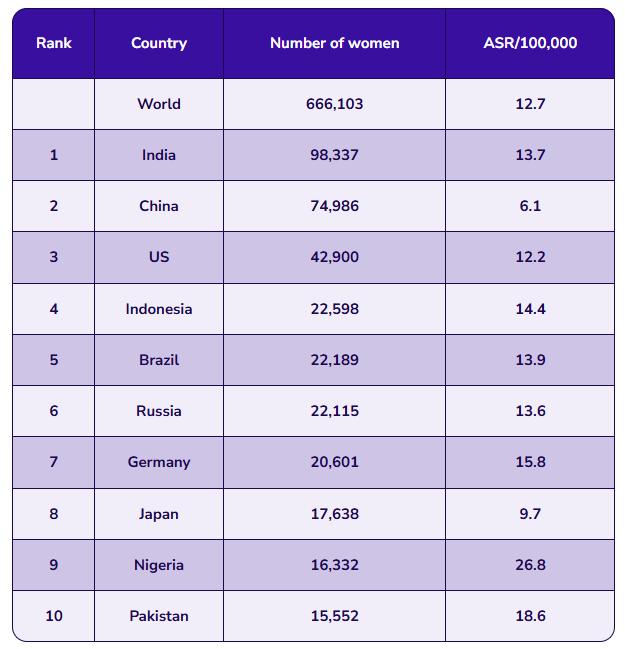
Thismodeladdressesthesechallengesbycombiningthe deep learning technologies with the RSNA Screening Mammography Breast Cancer Detection dataset which contains54,000mammogramsandpatientmetadata. Theworkflowcomprisesthreestages:
Data Preprocessing: Images are standardized (512x512 pixels grayscale normalization) and metadata (ages, implant status) is integrated usingz-scorescaling.
A refined-tuned EfficientNetV2-B3 backbone extracts mammogram features trained on an 80:20datasplitforrobustness(precision:82% recall:85%F1-Score:0.83).
ADjango-basedwebapplicationenablesclinicians to upload scan and metadata, generating real time predictions with malignancy probability, invasivenessgradinganda“predictiondifficulty” metricforthe
Thisinnovationbridgesgapsinglobalhealthcareequity by providing a cost-effective, rapid and reliable tool to combatthedevastatingeffectsofbreastcancercausedwhich couldbefataltoo.
The integration of Deep Learning (DL) into breast cancer diagnosticsshowsaparadigmshift,offeringanon-invasive, cost-effective,andscalablealternativetotraditionalmethods. Central to this project is a fine-tuned EfficientNetV2-B3 architecture, optimized to analyze the “RSNA Screening MammographyBreastCancerDetection”dataset aglobally recognizedrepositorycomprisingover54,000mammogram imagespairedwithpatientmetadata(age,breastlaterality, implantstatus,andimagingviews).

Unlikesimplermethods,thissystememploysdeeplearning to identify complex patterns and features in mammogram images.Thisapproachconsidersthepixeldataalongwiththe patient'smetadataincludingage,view,lateralityandimplant status. These features comprehensively capture details critical for diagnosis. Below shown diagram is our model working and predicting outputs by taking standard mammogram and certain other data like age of patient , if patient had an implant , view of mammogram MLO “MediolateralOblique” andCC“Craniocaudalview”andifits leftorrightbreast,predictstheoutput.
Thisapproachnotonlyautomatestumorclassificationbut also provides interpretable outputs (e.g., malignancy probability,invasivenessscores)toguideclinicaldecisionmaking,settinganewstandardforAI-drivenoncologytools.
Theprimarydataconsistsofmammogramimages,whichare complexvisualrepresentationsofbreasttissue.Thedataset isdesignedforthedevelopmentofdetectionalgorithms,with the goal of distinguishing between normal and abnormal findings. The images are provided with annotations specifyingwhetheranabnormalityisbenignormalignant. Theseimagesandmetadataareusedtotraindeeplearning models. Worst-case values indicate the most extreme measurements.

International Research Journal of Engineering and Technology (IRJET) e-ISSN: 2395-0056
Volume: 12 Issue: 02 | Feb 2025 www.irjet.net p-ISSN: 2395-0072
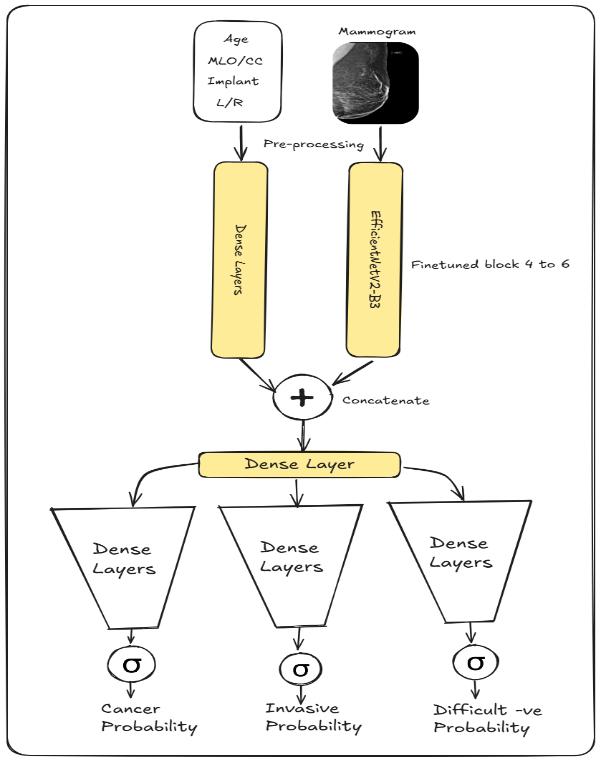
Fig -1:ModelArchitecture
Thedeeplearningmodelbasedonfine-tunedEfficientNetV2B3isthentrainedonthepre-processeddatasettoestablisha relationshipbetweeninputfeaturesandtumorclassification. Theeffectivenessofthemodelisanalyzedusingmetricssuch asaccuracyprecisionrecallandF1score.Withthesemetrics providing insight into the model’s ability to accurately distinguish benign and malignant tumors minimising false negative(criticalinmedicaldiagnostics).
The methodology follows a step-by-step approach to designing, implementing, and evaluating a deep learning modelforbreastcancerclassification.Theaimistodevelop a reliable system for distinguishing between benign and malignantbreastmassesbasedonmammogramimagesand patientmetadata.Thedetailedmethodologyisasfollows:
1. Data Collection and Preprocessing:
The “RSNA Screening Mammography Breast Cancer Detection”datasetwasusedforthisstudy.Thedataset contains mammogram images, each labelled with accompanyingpatientmetadata.
Images were extracted, resized, and normalized.
Patient metadata (age, view, laterality, implantstatus)wasintegrated.
2. Model Selection:
A custom deep learning model based on a fine-tuned EfficientNetV2-B3 architecture is used as the primary classifier due to its capability to learn complex image featuresandintegratetabulardata.
3. Data Splitting:
In the ratio of 80-20 dataset splitting was done into trainingandtestingsubsets
TrainingSet:Usedfordata-modeltraining (80%ofthedata).
Testing Set: Used for model evaluation (20%ofthedata).Arandomseed(random state=42) was fixed to ensure reproducibility.
4. Model Training:
Deeplearningmodelwastrainedonthescaledtraining data.Duringtraining,themodellearnedoptimalweights by minimizing the loss function. Regularization was usedtopreventoverfitting.
5. Model Evaluation:
Thetrainedmodelwasevaluatedonthetestingdataset usingkeymetrics:
Accuracy: Measures the percentage of accuratelyclassifiedsamples.
Precision:Theproportionoftruepositive predictionsamongallpositivepredictions.
Recall: The proportion of pure positives identifiedoutofallactualpositives.
6. Implementation with Django:
Developedauser-friendlywebapplicationusingDjango toenablereal-timepredictions:
Diagnostic centers upload mammogram imagesandprovidemetadata.
The app scales and processes input data and makes predictions using the trained deeplearningmodel.
Outputsinclude:
- Prediction(benignormalignant).
- Probabilityscoresforbothclasses.
- Diagnosticreports.
Here is a flow of web application and how the result is showntouserisshownbelow,thisisawebapplicationfor bothdiagnosticcenterandtheuserorpatientwhohaswent forscanthereinthatdiagnosticcenter
Herethefirststepafterpatientvisitsthediagnosticcanter where she gives here information and appears for a mammogramafterthatdiagnosticcentercreatestheuserif theyvisitedforthefirsttimebyusingtheirphonenumberto be patient ID as it will always be unique otherwise if the patientisrevisitingtheywillsearchforpatientandinboth thecasestheywillattachthemammogramscansalongwith

International Research Journal of Engineering and Technology (IRJET) e-ISSN: 2395-0056
Volume: 12 Issue: 02 | Feb 2025 www.irjet.net p-ISSN: 2395-0072
theinformationrequiredtobesenttomodelforprediction scan and meta data of patient is sent to the model for prediction.
Oncethisisdonethepatientwillreceiveamailstatingthat theyareadded,andtheycanchecktheirstatusbyloginto thesystem.
Whenthepatientlogsinandcheckstheywillarriveathome pagewhereassoonastheresultisready,theycanviewit andindiagnosticdashboardthestatuswillbeupdated.
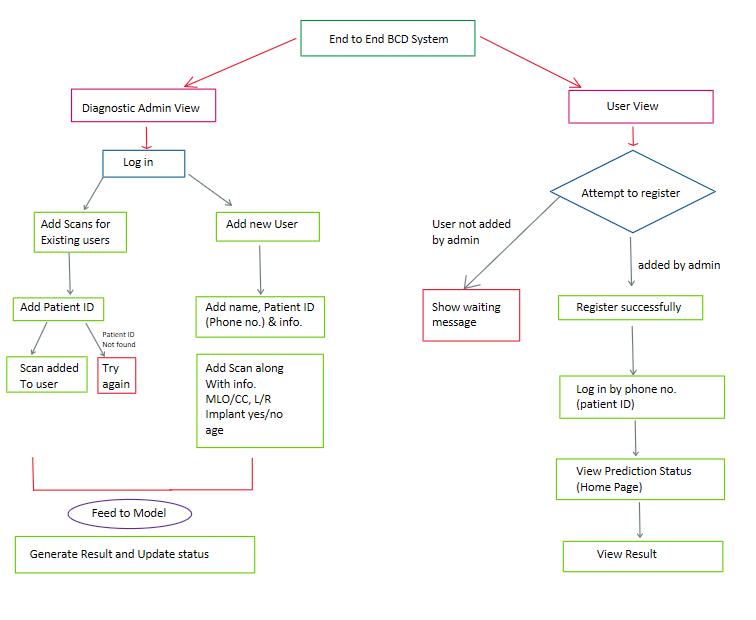
7. Deployment and Testing
The application was deployed locally for testing and validationTherobustnessofthemodelwasvalidatedby testingwithunseendata.
This systematic methodology ensures a reliable, interpretable, and scalable solution for early breast cancer detection, emphasizing both clinical relevance andpracticalapplicability.
8. Snapshots of website


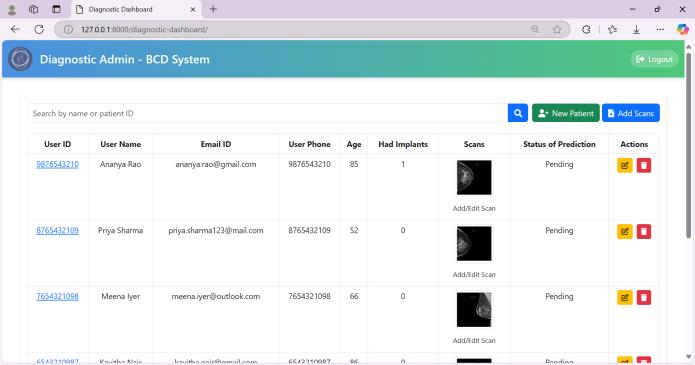
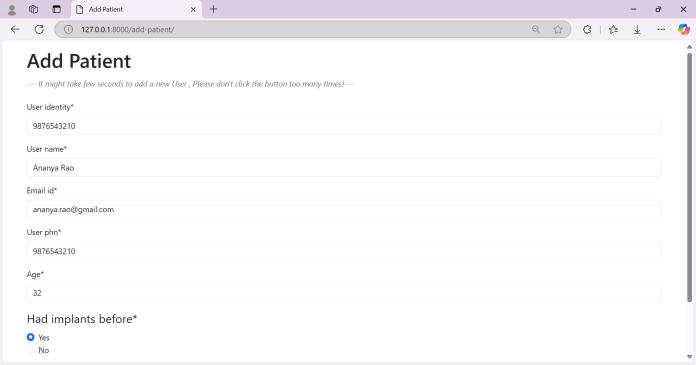
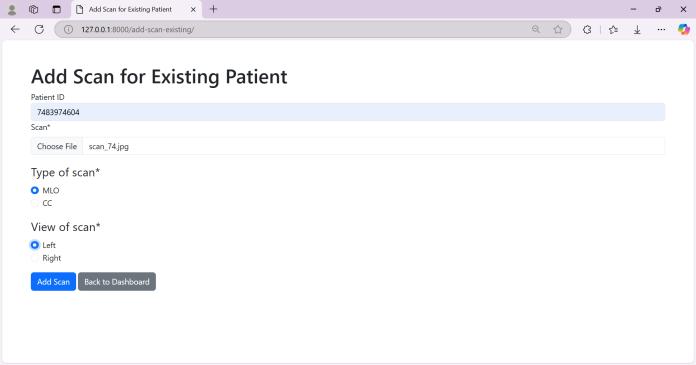

International Research Journal of Engineering and Technology (IRJET) e-ISSN: 2395-0056
Volume: 12 Issue: 02 | Feb 2025 www.irjet.net p-ISSN: 2395-0072


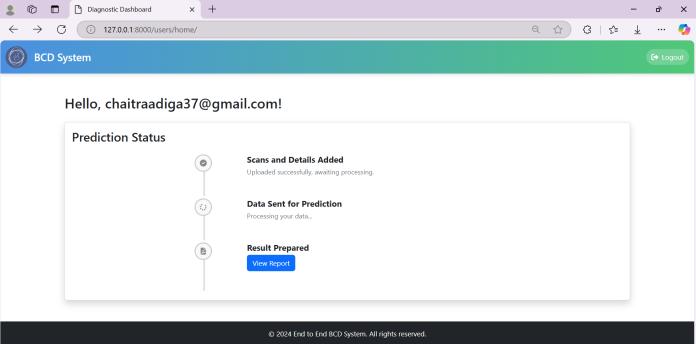
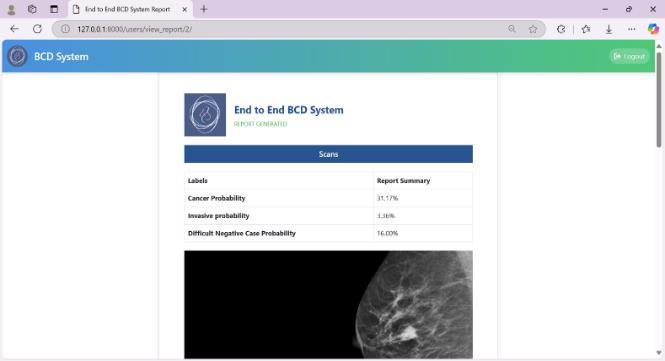
Ourapplicationsystemusedtopredictthepresenceofearly breastcancerisabletobecomeasound,efficient,andeasyto-usediagnosticassistantforhealthprofessionals.Hereare themainconclusionsfromthisproject:
1. The accuracy of the deep learning model is about 84% and can identify between benign and malignant breast masses. It concludes how the modelcanbeofhelpinclinicaldecision-making.
2. The preprocessing of image data was vital in optimizing model performance and distributing weightsfairlyamongallinputfeatures.Thisshows howpreprocessinghasamajorroleintheworkflow ofDeepLearning.
3. AninteractiveDjangowebapplicationcanbebuilt, whichcanallowthemodeltobeaccessedforrealtimepredictions.Itwouldenabledoctorstoupload images and get the predictions with associated probabilityscoresanddiagnosticreports.
4. The model has the ability to decrease unrequired biopsiesandsurgeries,especiallyinlow-resource settings.
5. Achieving good performance on the “RSNA ScreeningMammographyBreastCancerDetection” dataset proves that the model has the ability to providereliablediagnostichelp.
Other alterations such as the addition of larger and more diverse datasets will enhance the model's ability to generalize to other populations and imaging modalities. Otherdeeplearningarchitecturesthanthoseusedherecan also be investigated for further gains in accuracy and robustness.Amobileversionoftheapplicationmaymake access more accessible, especially in distant or underdeveloped areas. Techniques to explain individual predictions may be added to increase trust and transparency. The Breast Cancer Detection System is a fundamentalsteptowardimprovingdiagnosticsforbreast cancer with Deep Learning techniques and has much potentialforreal-worldimpact.
[1] Zhang, Y., & Wang, L. (2020). Breast Cancer DetectionUsingDeepLearning:AComprehensive Survey.JournalofHealthcareEngineering,2020.
[2] Liu, X., et al. (2021). Mammogram Classification Using Convolutional Neural Networks: A Review. ComputationalBiologyandMedicine,2021.

International Research Journal of Engineering and Technology (IRJET) e-ISSN: 2395-0056
Volume: 12 Issue: 02 | Feb 2025 www.irjet.net p-ISSN: 2395-0072
[3] Smith,R.A.,etal.(2019).BreastCancerScreening: TheRoleofEarlyDetectioninReducingMortality. TheLancet,2019.
[4] Rastegar, S., & Beheshti, M. (2022). AI-Based Medical Imaging in Cancer Diagnosis. Artificial IntelligenceinMedicine,2022.
[5] R.B.Mim,A.B.Islam,S.RoyandA.Sattar,"Breast CancerDetectionusingDeepLearningApproach," 2022 International Conference on Electrical, Computer and Energy Technologies (ICECET), Prague, Czech Republic, 2022, pp. 1-7, doi: 10.1109/ICECET55527.2022.9872893.
[6] Bhattacharya, S., & Das, A. (2020). A Review of Image Processing Techniques for Breast Cancer Diagnosis.JournalofDigitalImaging,2020.
[7] WorldHealthOrganizationinformationtakenfrom https://www.who.int/news-room/factsheets/detail/breast-cancer
[8] Tabular information of Breast Cancer Cases and Breast cancer Deaths globally for year 2022 obtainedfrom-https://www.wcrf.org/preventingcancer/cancer-statistics/breast-cancer-statistics/K. Elissa,“Titleofpaperifknown,”unpublished.
[9] [2021]EfficientNet:zRethinkingModelScalingfor ConvolutionalNeuralNetworks.Authors:Mingxing Tan,QuocV.Le
[10] Liu X., Li Y., Zheng Y. [2020] Mammogram ClassificationUsingDeepLearning.